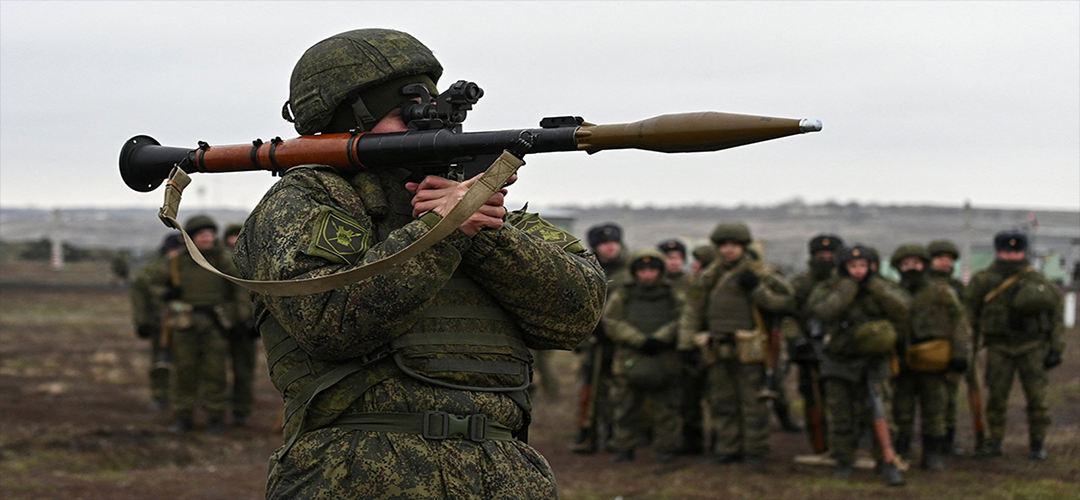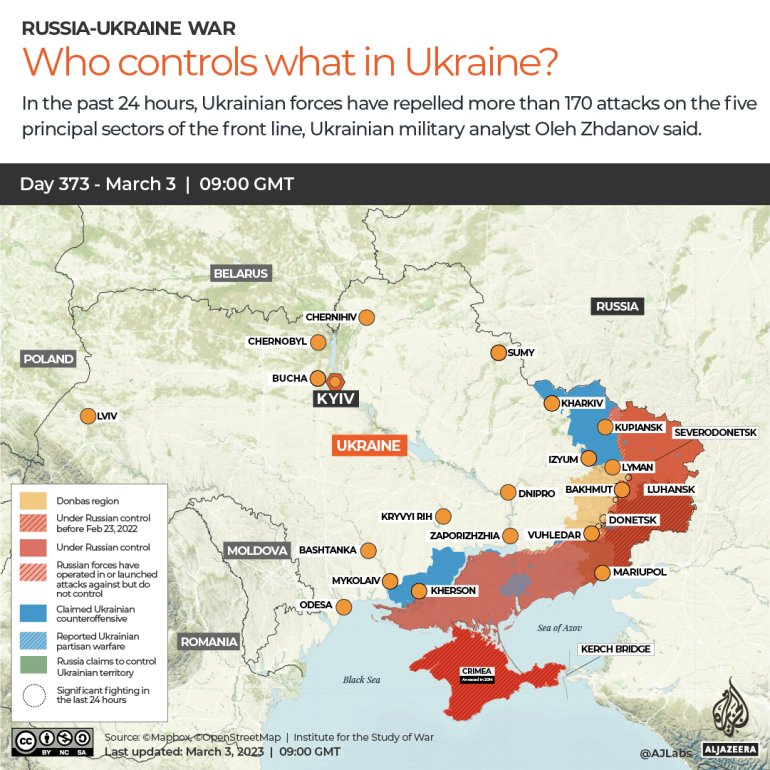Who Blinks First?
March 4, 2023 | Expert Insights

This week the war in Ukraine completed its first year. With hostilities showing no sign of abating and the Russians gearing up for another bloody assault on the eastern Donbas region, the war seems as intense as last year.
Military strategists are vying with each other to predict the trajectory of the war through 2023, while militaries globally are trying hard to absorb the lessons of the war, especially those whose equipment profile mimics the Russians. So where is this conflict headed?
Background
When Russian armoured spearhead rolled across the international border into Ukrainian territory, few gave Ukraine more than a few weeks before their resistance would be stream rolled and the Russian flag would fly over Kyiv. Even seasoned American generals who have spent a lifetime monitoring the Russian armed forces expected little more than a token resistance before the collapse of the Ukrainian Army. A year later, things have not turned out as both sides (and their supporters) anticipated.
Ukraine, although still beleaguered, is very much in a fine mettle not only to break Russian attacks but also to take the fighting into Russia, especially once offensive western weapons flow in later this year. Russia may not have made much headway in North or West Ukraine (from where it was forced into an ignominious retreat) but has definitely extended its occupation of the South East inhabited by ethnic Russians. Its current military offensives are accordingly focussed on this region, which it clearly wants to annexe permanently like Crimea.
When the Russian invasion of Ukraine began a year ago, reactions from the international community were rapid – the USA and the EU, along with their G7 counterparts, issued swift sanctions, aiming to isolate Russia and cripple its economy, thus hoping to render it financially bankrupt, unable to fund its military and continue the war. On the one-year anniversary of the conflict, the EU announced its 10th package of sanctions. In combination with the previous sets of sanctions, this package also banned seven Iranian entities from trading with Russia (these entities were supplying drones to the Russian military). The effect of sanctions, however, has not been as effective in isolating the Russian economy as those enforcing it may have hoped.

Analysis
The Russian economy only fell by 2.2 per cent, as opposed to the predicted 15 per cent from western economists. Furthermore, predictions for Russian growth in 2023 are moderately optimistic – the IMF forecasts a growth of 0.3 per cent. On the other hand, Ukraine experienced a shocking 30.4 per cent drop in the gross domestic product – the biggest fall in economic growth since its independence from the Soviet Union in 1991. Unlike Russia, which was able to continue its main exports (oil and gas) despite sanctions, Ukraine's exports suffered a 35 per cent drop – a worrying statistic considering Ukraine is a leading producer and exporter of grains (invaluable to maintain the global food chain).
However, there has been a steady flow of foreign aid – both in cash and kind – into Ukraine. Over $31 billion dollars has been sent to Ukraine to aid the war effort along with supplies of military tanks and planes (movable military infrastructure). The IMF has predicted minimal economic growth in 2023 and 2024 in anticipation of the huge restructuring and rebuilding efforts that Ukraine's government will have to undertake once the war is over. Ukraine's president, Volodymyr Zelensky, has already begun to woo investors to reconstruct power plants, hospitals, schools and other civilian infrastructure.
Few expected the war to have such a global ripple effect. According to the UN's Global Crisis Response Group, the conflict exacerbates three global crises – food shortage, energy shortage and financial instability. Over 107 economies worldwide are expected to face the brunt of the conflict through the impact of any of these three crises – irrespective of their allegiance to Russia or Ukraine.
The two largest producers of food grains are locked in a conflict. Russia and Ukraine produce 25 per cent of all traded wheat, more than 75 per cent of traded sunflower oil, and 16 per cent of all traded maize. At least 60 per cent of the grain supply produced remains stuck in both countries, unable to find a way to enter the global supply chain because of high insurance premiums on shipping in war zones. Countries in Africa and the Middle East like Somalia, Egypt, Lebanon, and Yemen are heavily dependent on Russia and Ukraine’s grain exports – delays in shipping and supply have caused food prices to rise significantly by at least 10-15 per cent in these countries.
There has also been a growing ambivalence from third-party countries towards the Ukrainian-Russian conflict. Over a third of member countries abstained from voting on the UN resolution to condemn Russia for its actions at the emergency session held by the General Assembly soon after the invasion occurred. While countries like South Korea and Japan provide aid and support for Ukraine, China positions itself as an important trade and military partner for Russia. At the same time, India continues to be one of Russia's biggest customers for oil.
Russia underestimated the global response to the invasion and the effectiveness of its military forces. Putin is now in a position where he must fulfil the promises made before the invasion of uniting previously lost territories under Russia. Zelensky and Ukraine, on the other hand, are wary of diminishing interest in the West and are stridently crying for upping the ante by demanding a bigger package of offensive western weapons like tanks, artillery, and aircraft to switch from purely defensive to an offensive-defensive posture.
One fallout of the war has been amply highlighted- a new world order is slowly emerging in the aftermath of the COVID-19 pandemic and the debilitating Eastern European War. While Russia is locked in a death grip with a stubborn Ukraine, NATO and its leader U.S. are pouring billions in arms and ammunition into the war. Even cessation of hostilities may not bring economic salvation as the reconstruction of a devastated Ukraine will consume hundreds of billions, a sum that Ukraine does not have. The West will have to invoke a new Marshall Plan.
The war has led to an economic downturn that could grievously impact industries aiming to recover from over two years of slower business. This will make mustering financial resources for the reconstruction of Ukraine that much more cumbersome.
However, amidst all this death and destruction and collapsing economies, Asia seems to be doing reasonably well. Having finally abandoned its 'Zero Covid Policy,' Chinese economic parameters are rising. India has been a surprising wild card amidst the COVID crisis and the War in Ukraine- it showed remarkable resilience in dealing with the pandemic launching the world's largest immunisation drive with domestic resources and has survived the economic aftermath of the lockdowns and the Ukraine-induced disruptions. With nearly 6 per cent growth predicted, India can act as an engine of growth along with China, Vietnam and other countries of the Indo-Pacific.
Assessment
- The war must be ended at the earliest so that peace can be crafted for the region. Russia erred in underestimating the response of the West, and some would say that it walked into a well-laid trap, with the Ukrainian people as the bait! Like a trapped bear, it must either cut away its trapped limbs and walk away from the fight or endure and watch its nation perish economically and militarily or, worse, turn into an impoverished third-world economic basket case. It is hoped that Mr Putin would opt for the former.
- We might yet see a 21st-century form of non-alignment return to the global political order. As a way of establishing itself in a new world order and to reduce the influence of the West, many countries in Asia and Africa have refrained from choosing sides in this conflict, despite the pressure brought to bear upon them by their benefactors.
- Mr Putin has been rattling the nuclear sabre from the first day of the conflict, prompting the Doomsday Clock's guardians to advance it closer to the nuclear midnight. Let us hope that Russia is not driven into a cul de sac that, like a cornered predator, it strikes with its ultimate death weapon. Then definitely, there will be only losers in this war.








Comments